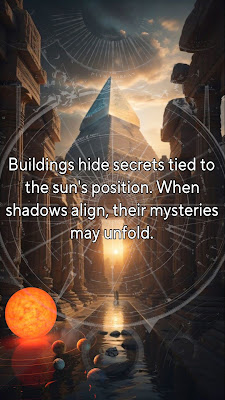In modern architecture, how are solstices and the path of the sun sometimes used symbolically in building design?
Solstices are astronomical events that mark the two points in Earth's orbit around the Sun when the tilt of the Earth's axis is either tilted most toward (summer solstice) or away from (winter solstice) the Sun. There are two solstices in a year:
Certainly! Solstices are special times of the year when something interesting happens in the sky. To understand solstices, let's talk about the Sun, our closest star, and the Earth, the planet we live on.
1. Earth's Tilt:
- Imagine a straight line going through the Earth from the North Pole to the South Pole. This is like an imaginary stick going through our planet.
- Earth is a bit like a spinning top that's a little tilted. This tilt is about 23.5 degrees.
2. What Happens Because of the Tilt:
- Because of Earth's tilt, different parts of our planet get varying amounts of sunlight at different times of the year.
- When the North Pole tilts toward the Sun, it's summer in the Northern Hemisphere (the top half of the Earth), and that's the summer solstice.
- When the South Pole tilts toward the Sun, it's summer in the Southern Hemisphere (the bottom half of the Earth), and that's the summer solstice there.
3. Two Solstices:
- There are two solstices in a year: the summer solstice and the winter solstice.
- The summer solstice happens around June 20th or 21st. It's the longest day of the year in the Northern Hemisphere because the North Pole is tilted most toward the Sun.
- The winter solstice happens around December 20th or 21st. It's the shortest day of the year in the Northern Hemisphere because the North Pole is tilted most away from the Sun.
4. Cultural Significance:
- People have celebrated solstices for a very long time. They mark important moments when the amount of daylight changes.
- In many cultures, the summer solstice is a time for festivals and celebrations because it's the peak of warmth and sunlight.
- The winter solstice is often associated with holidays like Christmas, Hanukkah, and others, as it marks the return of longer days and the promise of spring.
Solstices have been of cultural and astronomical significance throughout human history, often serving as markers for the changing seasons and the timing of various agricultural and religious events. They are key events in Earth's annual journey around the Sun and have been studied and celebrated in various ways by different cultures around the world.
5. Simple Takeaway:
- Solstices are like the Earth's way of saying hello to the Sun, with a big tilt.
- Summer solstice means longer days and warmer weather, while winter solstice means shorter days and colder weather, depending on where you live.
In a nutshell, solstices are special times when Earth's tilt makes some parts of the world super sunny and warm (summer) and others not so sunny and chilly (winter). These moments are important for our calendars and have cultural celebrations tied to them.
In the Southern Hemisphere, the dates are reversed, so the summer solstice occurs around December 20th or 21st, and the winter solstice occurs around June 20th or 21st.
Solstices Along with Architecture
Solstices have been of significant importance in various architectural designs, especially in ancient civilizations, where the alignment of buildings and structures with the solstices played a crucial role. Here's how solstices have influenced architecture:
1. Solar Alignment in Ancient Temples and Monuments:
- Many ancient cultures, such as the Egyptians, Mayans, and Celts, constructed temples, pyramids, and stone circles with precise solar alignments.
- For example, the Great Pyramid of Giza in Egypt is aligned to the cardinal directions and is believed to have served as a monument to the sun god Ra, with its sides facing the cardinal points.
2. Summer and Winter Solstice Alignment:
- Some structures were designed to align with the rising or setting sun during the solstices.
- Stonehenge in England is famous for its alignment with the summer solstice sunrise, where the central axis points directly at the rising sun during the summer solstice.
3. Astronomical Observation and Calendars:
- Ancient observatories, like Newgrange in Ireland, Chichen Itza in Mexico, and Angkor Wat in Cambodia, were built to observe solstices and equinoxes.
- These structures allowed ancient astronomers to develop calendars based on celestial events and track the changing seasons.
4. Cultural and Ritual Significance:
- Solstices often held cultural and religious importance, and the architecture of temples and ceremonial sites was influenced by the desire to mark these astronomical events.
- The Intihuatana stone in Machu Picchu, Peru, is believed to have been used for ritual ceremonies during the winter solstice.
5. Architectural Symbolism:
- In modern architecture, the concept of solstices and the changing positions of the sun are sometimes used symbolically.
- For instance, some contemporary buildings are designed with facades or structures that change in appearance based on the angle of sunlight during different times of the year.
6. Passive Solar Design:
- In sustainable architecture, passive solar design principles take into account the path of the sun during different seasons.
- Buildings are designed to maximize or minimize solar heat gain depending on whether it's summer or winter, thus improving energy efficiency.
In summary, solstices have played a significant role in architectural design and cultural symbolism throughout history. Ancient civilizations often incorporated precise solar alignments into their structures, serving both practical and symbolic purposes. Even in modern architecture, the principles of solar design continue to be relevant for energy efficiency and aesthetic considerations.

Comments
Post a Comment